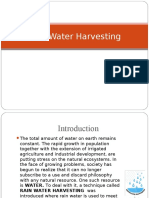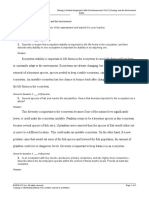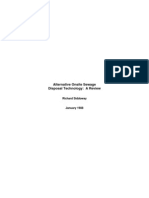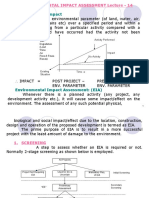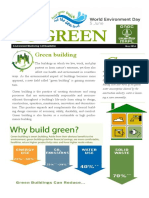Professional Documents
Culture Documents
IJISRT20JAN357
Original Title
Copyright
Available Formats
Share this document
Did you find this document useful?
Is this content inappropriate?
Report this DocumentCopyright:
Available Formats
IJISRT20JAN357
Copyright:
Available Formats
Volume 5, Issue 1, January – 2020 International Journal of Innovative Science and Research Technology
ISSN No:-2456-2165
Energy Prospect of Nigeria’s Municipal Solid Waste
Ojedokun, Olushola Ayobami,
B. Eng in Mechanical Engineering, Federal University of Technology, Minna, Nigeria [2006]
Abstract:- Waste is an indispensable part of human life. This paper evaluates the power resource value of
Biological, Medical, Agricultural, Industrial, Domestic Nigeria’s Municipal Solid Waste. It also captures Solid
wastes are generated continuously across races and Waste recovery strategies in place in Nigeria and how
places on the planet. It certainly cannot be eliminated the country could optimally exploit the man-made ‘filth’
but can be profitably managed. for her economic gains by emulating benchmarked
practices.
As a by-product of human and economic activities,
waste could be in the form of Gas (Vented gas/Flare), I. INTRODUCTION
liquid (Effluent/leachate) or Solid (Municipal Solid
Waste/particulates). Municipal solid waste is defined as household waste,
commercial solid waste, non-hazardous sludge,
Waste (which typical has large content of Solid conditionally exempt, small quantity hazardous waste, and
part) which might have seemingly been of no industrial solid waste (EPA-530-R-95-023 1995). MSW
significance a while ago is now being recognised as a includes food waste, rubbish from residential areas,
wealth. By research and technological innovations, heap commercial and industrial wastes, and construction and
of waste is presently sought in the modern world as a demolition debris3.
valuable resource for energy derivation. Countries like
Norway and Germany import waste for energy Though Solid waste have been traditional landfilled or
generation6. combusted, modern techniques of waste management now
includes reduction, reuse, recycling and recovery.
Nigeria recent population estimate hovers around
203 Million10. This populace generates an annual solid Reduction of Waste, Reuse of Waste and Recycling of
waste of more than 32 million tonnes of which only Waste are basically waste management techniques aimed at
about 20% -30 % is collected for reducing energy consumption level. However, realities
treatment/management; the remaining proportion is have emerged that Energy can be derived directly from
recklessly disposed12. waste via controlled Recovery method.
Nigeria can minimize waste by intensely exploring For a Standard Waste Management practice, after
waste control measures such as Reducing, Reusing, primary resource recovery from Waste, a secondary energy
Recycling or the Nation can maximally tap from the resource recovery would be carried out during
enormous energy potential of waste via multiscale/ combustion/incineration.
large-scale recovery mechanism & systems.
Below is a flow chart diagram illustrating the overall
Waste Management process.
IJISRT20JAN357 www.ijisrt.com 926
Volume 5, Issue 1, January – 2020 International Journal of Innovative Science and Research Technology
ISSN No:-2456-2165
Fig 1:- Diagram of Waste Hierarchy
(Source: Wikipedia14)
The diagram indicates recovery of material and Waste-to-Energy
Energy could be achieved after separation (or segregation) Waste-to-Energy (WTE) or energy-from-waste is the
of waste and incineration/composting respectively. At that process of generating energy in the form of electricity
point, a Waste-to-Energy Installation is vital for recovery of and/or heat from the incineration of waste11.
Energy form Waste via incineration.
Below is the Schematic diagram on the Process
involved in harnessing Energy from Waste.
Fig 2:- Waste to Energy Incineration Plant Diagram
(Source: Green Living Answers5)
IJISRT20JAN357 www.ijisrt.com 927
Volume 5, Issue 1, January – 2020 International Journal of Innovative Science and Research Technology
ISSN No:-2456-2165
Waste-To-Energy Technology
Proven technologies used for Derivation of Energy from Waste consists:
Thermal Technology (Direct Combustion): Mass Burn & Refuse Derived Fuel
Pyrolysis
Gasification: Conventional and Plasma Arc types
Tabulated below are short descriptions of the technologies
Technology Description
Thermal Technology: Mass Burn Mass Burn is the process of completely burning the waste while getting a residue of non-
and Refuse Derive Fuel combustible material. Useful Heat energy is generated during the burning
Refuse Derived Fuel (RDF) is the process of removing the recyclable and non-combustible
from the municipal solid waste (MSW) and producing a combustible material, by
shredding or pelletizing the remaining waste11.
Pyrolysis Thermo-chemical decomposition of organic material, at elevated temperatures without the
participation of oxygen 11. The process involves the simultaneous change of chemical
composition and physical phase that is irreversible11. Pyrolysis occurs at temperatures
>750°F (400°C) in a complete lack of oxygen atmosphere11. The syn-gas that is produced
during the reaction is generally converted to liquid hydrocarbons, such as biodiesel11. By-
products from the process are generally unconverted carbon and/or charcoal and ash 11.
Gasification Conventional Gasification is the thermal conversion of organic materials at temperature of
1,000 °F – 2,800 °F (540 °C – 1,540 °C), with a limited supply of air or oxygen (sub-
stoichiometric atmosphere)11. This is not combustion and therefore there is no burning11.
Gasification uses a fraction of the air/oxygen that is generally needed to combust a
given material and thus creates a low to medium Btu syn-gas11.
Plasma Arc Gasification is the process that utilizes a plasma torch or plasma arc using
carbon electrodes, copper, tungsten, hafnium, or zirconium to initiate the temperature
resulting in the gasification reaction11. Plasma temperature temperatures range from 4,000
°F – 20,000 °F (2,200 °C – 11,000 °C), creating not only a high value syn-gas but also
high value sensible heat11.
Table 1:- Description of WTE Technologies
Another Waste-to-Energy Technology which is not municipal solid waste in environmentally sound and
common compared to the Thermal/Composting technology sustainable manner 9.
is Landfill Gas Collection
Public private partnership Project to build an
The Landfill Gas, which is mostly Methane, is Integrated Waste Management Facility with various
collected from Landfill Sites for applicable energy use. components such as Sanitary Landfill, Scrap Metal
Recovery & Recycling Plant, Material Recovery Facility,
Of all the technologies listed above, the thermal Plastic Recycling Plant, Compost Plant, Leachate
process(incineration/combustion) is most popular. Treatment Plant, Biomedical Waste Incinerator etc., is
slowly underway in Nigeria due to inadequate funding9.
With the concept of Waste-to-Energy Process extensively
outlined above, let us X-ray Nigeria’s Initiatives/Models Eight incinerators have been installed and
put in place to recover Energy from Waste commissioned at eight federal medical institutions spread
across the country while Installation is on-going in about
II. BACKGOUND other fifteen federal institutions9.
Solid waste management in Nigeria is characterized Despite the efforts/initiatives, the Nation’s Waste-to
by inefficient collection methods, insufficient coverage of -Energy conversion rate is currently insignificant compared
the collection system and improper disposal9. Disposal in to the tonnes of waste routinely generated.
most Nigeria cities include, co-disposal of hazardous and
municipal waste in open, unlined dumps, open burning of Based on current realities such as poor collection
municipal solid wastes, dumping on water bodies and in efficiencies, Nigeria’s exploitable Waste-to-Energy
other unauthorized places9. capacity from Municipal Solid Waste is below
3800 GWh/year, with all the states having less than 50 MW
The Federal Ministry of Environment of Nigeria has capacity.
over the years embarked on intervention programmes to
assist the state and local governments manage their
IJISRT20JAN357 www.ijisrt.com 928
Volume 5, Issue 1, January – 2020 International Journal of Innovative Science and Research Technology
ISSN No:-2456-2165
Nigeria is expected to launch unto the full Energy III. METHOD/DERIVATIONS
prospect of her annually generated waste via aggressive
approaches & Mechanisms. Details of the Energy content of Waste is calculated by determining
Method/Derivations subheading below gives a hint at the the calorific value (CV) of the composition of referenced
Quantity of Energy derivable from Nigeria’s Solid Waste. waste.
The table below shows the heat content (or calorific
value) of different material a waste could be composed of.
Type of material CV (MJ / kg) CV (kCal / kg)
Medical waste 19 - 24 4540 - 5735
Industrial & hazardous waste 22 - 40 5257 - 9558
Domestic waste (without recycling) 7 - 16 1673 - 3823
Domestic waste (after recycling) 10 - 14 2389 - 3345
PVC 41 9797
Dry wood 14,4 3441
Paper 13,5 3226
Table 2:- Calorific Value of Waste Composition
(Source: Igniss Energy7)
Based on trend of generated waste composition along Also, an Energy Information Administration May
with corresponding Calorific content, some 2007 Publication indicates one (1) Ton of Municipal Solid
National/international energy organizations have valued the Waste has an average range value of 10 -11 Million British
energy content of specific Municipal Solid Waste Volume. Thermal Unit4.
Source(s) of Data that are used for computing the Computation
Energy content of Nigeria’s yearly waste are highlighted By making proportionate computations, Nigeria can
next. extract up to 358 trillion Btu fuel Value from more than 32
Million tons of Waste generated annually by her populace
Data Sources if managed properly.
According to a US Department of Energy Document,
138 Million short tons of Municipal Solid Waste has about The following table shows source/factor(s) used to
1.4 x 1015 British Thermal Unit (1.4 quadrillion Btu) fuel calculate the British Thermal Unit (Btu) Fuel Value of
value associated with it3. Nigeria’s Waste produced yearly.
Waste Volume (in Waste Volume (in British Thermal Unit (BTU) Factor(s)
tons) short tons) Fuel Value of Waste
US Data 138 Million 1.4 * 1015
Nigeria 32 Million 35.28 Million 358 * 1012 [1 short ton = 0.907 ton]
Table 3:- Nigeria’s Waste British Thermal Unit Fuel Value; including Computation Factors
In terms of Electricity, an electric energy worth 105 energy could be realized from the load of Waste shunned
Terawatt-Hour (Twh) could be obtained from Nigeria’s out yearly.
annual waste generated. However, considering 25%
conversion installation inefficiency, about 26 TWh of Highlighted in the table below are the factors
considered for arriving at the 26 TWh Energy value.
IJISRT20JAN357 www.ijisrt.com 929
Volume 5, Issue 1, January – 2020 International Journal of Innovative Science and Research Technology
ISSN No:-2456-2165
British Thermal Unit Waste Energy Content Waste Energy Content Factor
(BTU) Fuel Value of equivalent in Watt-Hour Unit (considering average
Waste Waste-to-Energy
Installation efficiency)
358 * 1012 105 Terawatt-Hour (Twh) 26 Terawatt-Hour [1BTU = 293.07 * 10-6 Kwh]
Factor
Incineration conversion efficiency for Electricity generation 1: 15-27% (21% average)
Gasification Efficiency1: 30%
Hence, 25% typical average efficiency of WTE Plant (Incineration & Gasification combined) used
Table 4:- Nigeria’s Waste Electrical Energy Equivalent (in Watt-Hour unit); including Computation Factors
Considering a population of 203 Million10, Nigeria REFERENCES
could generate an annual Energy per Capita value of 128
Kwh from Waste alone via engagement of modern/efficient [1]. Anu Antony (October 2017), What are some of the
waste management techniques. latest waste-to-energy technologies available?; available
at https://www.prescouter.com/2017/10/waste-to-energy-
IV. DISCUSSION/RECOMMENDATION technologies-available [Accessed online on January
07,2020]
Energy available to an individual determines to what [2]. Babayemi J.O., Dauda K.T. (2009); Evaluation of Solid
extent such individual would contribute to the economic Waste Generation, Categories and Disposal Options in
wellbeing of his/her society or Nation. Consequently, a Developing Countries: A Case Study of Nigeria; J. Appl.
country’s Energy per Capita Index largely depicts the Sci. Environ. Manage. September 2009 Vol. 13(3) 83 -
prosperity of the Country. 88, Available Online at www.bioline.org.br/ja
[3]. C Valkenburg, CW Walton BL Thompson, MA
Currently, Nigeria has less than 150 Kwh per capita Gerber, SB Jones, DJ Stevens (December 2008),
index while countries or regions that have developed robust Municipal Solid Waste (MSW) to Liquid Fuels
& sustainable energy mix (waste inclusive) such as Europe Synthesis, Volume 1: Availability of Feedstock and
has about 5,000 Kwh per capita mean value. Technology; Prepared for the U.S. Department of
Energy under Contract DE-AC05-76RL01830
To develop a robust Energy base and partly achieve [PNNL-18144]
Energy Security, Nigerian should invest in and sustain [4]. Energy Information Administration (May 2007),
widespread Waste-to-Energy technologies; especially the Methodology for Allocating Municipal Solid Waste to
commonly used modern thermal technology(incinerators). Biogenic and Non-Biogenic Energy; published by Energy
Information Administration, Office of Coal, Nuclear,
Policies and Regulations that have potentials to Electric and Alternate Fuels, U.S. Department of Energy,
bolster efficient Waste Management and Waste-to-Energy Washington DC 20585; Pg 6
implementations at domestic and industrial levels should be [5]. Green Living Answers (@2020 Green Living
formulated and enforced. Answers), Is Waste to Energy Incineration a Viable
Option: available at
V. CONCLUSION https://www.greenlivinganswers.com/archives/138
[Accessed online on January 06,2020]
Nigeria stands a chance of generating up to 3 GW of [6]. Helen Russell (June 2013), Trash to cash: Norway
Electricity power per year from waste turned out via leads the way in turning waste into energy: available
domestic/economic activities. at
https://www.theguardian.com/environment/2013/jun/1
By exploiting modern & world-class waste 4/norway-waste-energy [Accessed online on January
management principles & technologies, the Country’s 06,2020]
ambition of generating 20,000 Mega-Watts (20 GW) of [7]. Igniss Energy Incineration Technology, Calorific
power and securing uninterrupted power supply for the Value (CV) of Waste, available at
citizens would be integrally achieved. www.igniss.com/calorific-value-waste [Accessed
online on January 06,2020]
[8]. Maduka Nweke (December 28,2016), Waste
management: Lagos unveils new strategies: available at
https://www.sunnewsonline.com/waste-management-lagos-
unveils-new-strategies [ Accessed online on January
06,2020]
[9]. Olori Olufunke Babade, Status of Solid Waste
Management in Nigeria (Including Plastic); UNEP-
POPS-CW.2-CP06.En
IJISRT20JAN357 www.ijisrt.com 930
Volume 5, Issue 1, January – 2020 International Journal of Innovative Science and Research Technology
ISSN No:-2456-2165
[10]. PopulationStat world statistical data(@Population
Stat, 2017-2020), Nigeria Population: available at
https://populationstat.com/nigeria [Accessed online on
January 06,2020]
[11]. Thomas Stringfellow(2014), An Independent Engineering
Evaluation of Waste-to-Energy Technologies:
available at
https://www.renewableenergyworld.com/2014/01/13/a
n-independent-engineering-evaluation-of-waste-to-
energy-technologies [Accessed online on January
06,2020]
[12]. Wale Bakare (April 04,2019), Solid Waste
Management in Nigeria: available at
https://www.bioenergyconsult.com/solid-waste-
nigeria [Accessed online on January 06,2020]
[13]. Wikipedia(December 16, 2019), List of Countries by
Electricity Consumption; available at
https://en.m.wikipedia.org/wiki/List_of_countries_by_ele
ctricity_consumption [Accessed online on January 16,
2020.
[14]. Wikipedia (January 06, 2020), Waste Management:
available at
https://en.wikipedia.org/wiki/Waste_management [
Accessed online on January 06,2020]
IJISRT20JAN357 www.ijisrt.com 931
You might also like
- A Heartbreaking Work Of Staggering Genius: A Memoir Based on a True StoryFrom EverandA Heartbreaking Work Of Staggering Genius: A Memoir Based on a True StoryRating: 3.5 out of 5 stars3.5/5 (231)
- The Sympathizer: A Novel (Pulitzer Prize for Fiction)From EverandThe Sympathizer: A Novel (Pulitzer Prize for Fiction)Rating: 4.5 out of 5 stars4.5/5 (119)
- Never Split the Difference: Negotiating As If Your Life Depended On ItFrom EverandNever Split the Difference: Negotiating As If Your Life Depended On ItRating: 4.5 out of 5 stars4.5/5 (838)
- Devil in the Grove: Thurgood Marshall, the Groveland Boys, and the Dawn of a New AmericaFrom EverandDevil in the Grove: Thurgood Marshall, the Groveland Boys, and the Dawn of a New AmericaRating: 4.5 out of 5 stars4.5/5 (265)
- The Little Book of Hygge: Danish Secrets to Happy LivingFrom EverandThe Little Book of Hygge: Danish Secrets to Happy LivingRating: 3.5 out of 5 stars3.5/5 (399)
- Grit: The Power of Passion and PerseveranceFrom EverandGrit: The Power of Passion and PerseveranceRating: 4 out of 5 stars4/5 (587)
- The World Is Flat 3.0: A Brief History of the Twenty-first CenturyFrom EverandThe World Is Flat 3.0: A Brief History of the Twenty-first CenturyRating: 3.5 out of 5 stars3.5/5 (2219)
- The Subtle Art of Not Giving a F*ck: A Counterintuitive Approach to Living a Good LifeFrom EverandThe Subtle Art of Not Giving a F*ck: A Counterintuitive Approach to Living a Good LifeRating: 4 out of 5 stars4/5 (5794)
- Team of Rivals: The Political Genius of Abraham LincolnFrom EverandTeam of Rivals: The Political Genius of Abraham LincolnRating: 4.5 out of 5 stars4.5/5 (234)
- Shoe Dog: A Memoir by the Creator of NikeFrom EverandShoe Dog: A Memoir by the Creator of NikeRating: 4.5 out of 5 stars4.5/5 (537)
- The Emperor of All Maladies: A Biography of CancerFrom EverandThe Emperor of All Maladies: A Biography of CancerRating: 4.5 out of 5 stars4.5/5 (271)
- The Gifts of Imperfection: Let Go of Who You Think You're Supposed to Be and Embrace Who You AreFrom EverandThe Gifts of Imperfection: Let Go of Who You Think You're Supposed to Be and Embrace Who You AreRating: 4 out of 5 stars4/5 (1090)
- Her Body and Other Parties: StoriesFrom EverandHer Body and Other Parties: StoriesRating: 4 out of 5 stars4/5 (821)
- The Hard Thing About Hard Things: Building a Business When There Are No Easy AnswersFrom EverandThe Hard Thing About Hard Things: Building a Business When There Are No Easy AnswersRating: 4.5 out of 5 stars4.5/5 (344)
- Hidden Figures: The American Dream and the Untold Story of the Black Women Mathematicians Who Helped Win the Space RaceFrom EverandHidden Figures: The American Dream and the Untold Story of the Black Women Mathematicians Who Helped Win the Space RaceRating: 4 out of 5 stars4/5 (890)
- Elon Musk: Tesla, SpaceX, and the Quest for a Fantastic FutureFrom EverandElon Musk: Tesla, SpaceX, and the Quest for a Fantastic FutureRating: 4.5 out of 5 stars4.5/5 (474)
- The Unwinding: An Inner History of the New AmericaFrom EverandThe Unwinding: An Inner History of the New AmericaRating: 4 out of 5 stars4/5 (45)
- The Yellow House: A Memoir (2019 National Book Award Winner)From EverandThe Yellow House: A Memoir (2019 National Book Award Winner)Rating: 4 out of 5 stars4/5 (98)
- On Fire: The (Burning) Case for a Green New DealFrom EverandOn Fire: The (Burning) Case for a Green New DealRating: 4 out of 5 stars4/5 (73)
- Trickling FilterDocument26 pagesTrickling FilterMayank SaxenaNo ratings yet
- Design of Septic TankDocument5 pagesDesign of Septic TankPangerwati OzukumNo ratings yet
- The Gersmehl Model ExplainedDocument7 pagesThe Gersmehl Model ExplainedRosie AustinNo ratings yet
- Securing Document Exchange with Blockchain Technology: A New Paradigm for Information SharingDocument4 pagesSecuring Document Exchange with Blockchain Technology: A New Paradigm for Information SharingInternational Journal of Innovative Science and Research TechnologyNo ratings yet
- The Effect of Time Variables as Predictors of Senior Secondary School Students' Mathematical Performance Department of Mathematics Education Freetown PolytechnicDocument7 pagesThe Effect of Time Variables as Predictors of Senior Secondary School Students' Mathematical Performance Department of Mathematics Education Freetown PolytechnicInternational Journal of Innovative Science and Research TechnologyNo ratings yet
- Perceived Impact of Active Pedagogy in Medical Students' Learning at the Faculty of Medicine and Pharmacy of CasablancaDocument5 pagesPerceived Impact of Active Pedagogy in Medical Students' Learning at the Faculty of Medicine and Pharmacy of CasablancaInternational Journal of Innovative Science and Research TechnologyNo ratings yet
- Formation of New Technology in Automated Highway System in Peripheral HighwayDocument6 pagesFormation of New Technology in Automated Highway System in Peripheral HighwayInternational Journal of Innovative Science and Research TechnologyNo ratings yet
- Supply Chain 5.0: A Comprehensive Literature Review on Implications, Applications and ChallengesDocument11 pagesSupply Chain 5.0: A Comprehensive Literature Review on Implications, Applications and ChallengesInternational Journal of Innovative Science and Research TechnologyNo ratings yet
- Exploring the Clinical Characteristics, Chromosomal Analysis, and Emotional and Social Considerations in Parents of Children with Down SyndromeDocument8 pagesExploring the Clinical Characteristics, Chromosomal Analysis, and Emotional and Social Considerations in Parents of Children with Down SyndromeInternational Journal of Innovative Science and Research TechnologyNo ratings yet
- Intelligent Engines: Revolutionizing Manufacturing and Supply Chains with AIDocument14 pagesIntelligent Engines: Revolutionizing Manufacturing and Supply Chains with AIInternational Journal of Innovative Science and Research TechnologyNo ratings yet
- The Making of Self-Disposing Contactless Motion-Activated Trash Bin Using Ultrasonic SensorsDocument7 pagesThe Making of Self-Disposing Contactless Motion-Activated Trash Bin Using Ultrasonic SensorsInternational Journal of Innovative Science and Research TechnologyNo ratings yet
- Beyond Shelters: A Gendered Approach to Disaster Preparedness and Resilience in Urban CentersDocument6 pagesBeyond Shelters: A Gendered Approach to Disaster Preparedness and Resilience in Urban CentersInternational Journal of Innovative Science and Research TechnologyNo ratings yet
- Enhancing the Strength of Concrete by Using Human Hairs as a FiberDocument3 pagesEnhancing the Strength of Concrete by Using Human Hairs as a FiberInternational Journal of Innovative Science and Research TechnologyNo ratings yet
- Natural Peel-Off Mask Formulation and EvaluationDocument6 pagesNatural Peel-Off Mask Formulation and EvaluationInternational Journal of Innovative Science and Research TechnologyNo ratings yet
- Teachers' Perceptions about Distributed Leadership Practices in South Asia: A Case Study on Academic Activities in Government Colleges of BangladeshDocument7 pagesTeachers' Perceptions about Distributed Leadership Practices in South Asia: A Case Study on Academic Activities in Government Colleges of BangladeshInternational Journal of Innovative Science and Research TechnologyNo ratings yet
- Handling Disruptive Behaviors of Students in San Jose National High SchoolDocument5 pagesHandling Disruptive Behaviors of Students in San Jose National High SchoolInternational Journal of Innovative Science and Research TechnologyNo ratings yet
- Safety, Analgesic, and Anti-Inflammatory Effects of Aqueous and Methanolic Leaf Extracts of Hypericum revolutum subsp. kenienseDocument11 pagesSafety, Analgesic, and Anti-Inflammatory Effects of Aqueous and Methanolic Leaf Extracts of Hypericum revolutum subsp. kenienseInternational Journal of Innovative Science and Research TechnologyNo ratings yet
- REDLINE– An Application on Blood ManagementDocument5 pagesREDLINE– An Application on Blood ManagementInternational Journal of Innovative Science and Research TechnologyNo ratings yet
- Placement Application for Department of Commerce with Computer Applications (Navigator)Document7 pagesPlacement Application for Department of Commerce with Computer Applications (Navigator)International Journal of Innovative Science and Research TechnologyNo ratings yet
- Optimization of Process Parameters for Turning Operation on D3 Die SteelDocument4 pagesOptimization of Process Parameters for Turning Operation on D3 Die SteelInternational Journal of Innovative Science and Research TechnologyNo ratings yet
- Advancing Opthalmic Diagnostics: U-Net for Retinal Blood Vessel SegmentationDocument8 pagesAdvancing Opthalmic Diagnostics: U-Net for Retinal Blood Vessel SegmentationInternational Journal of Innovative Science and Research TechnologyNo ratings yet
- Adoption of International Public Sector Accounting Standards and Quality of Financial Reporting in National Government Agricultural Sector Entities, KenyaDocument12 pagesAdoption of International Public Sector Accounting Standards and Quality of Financial Reporting in National Government Agricultural Sector Entities, KenyaInternational Journal of Innovative Science and Research TechnologyNo ratings yet
- A Curious Case of QuadriplegiaDocument4 pagesA Curious Case of QuadriplegiaInternational Journal of Innovative Science and Research TechnologyNo ratings yet
- A Knowledg Graph Model for e-GovernmentDocument5 pagesA Knowledg Graph Model for e-GovernmentInternational Journal of Innovative Science and Research TechnologyNo ratings yet
- Machine Learning and Big Data Analytics for Precision Cardiac RiskStratification and Heart DiseasesDocument6 pagesMachine Learning and Big Data Analytics for Precision Cardiac RiskStratification and Heart DiseasesInternational Journal of Innovative Science and Research TechnologyNo ratings yet
- Forensic Evidence Management Using Blockchain TechnologyDocument6 pagesForensic Evidence Management Using Blockchain TechnologyInternational Journal of Innovative Science and Research TechnologyNo ratings yet
- Analysis of Financial Ratios that Relate to Market Value of Listed Companies that have Announced the Results of their Sustainable Stock Assessment, SET ESG Ratings 2023Document10 pagesAnalysis of Financial Ratios that Relate to Market Value of Listed Companies that have Announced the Results of their Sustainable Stock Assessment, SET ESG Ratings 2023International Journal of Innovative Science and Research TechnologyNo ratings yet
- Pdf to Voice by Using Deep LearningDocument5 pagesPdf to Voice by Using Deep LearningInternational Journal of Innovative Science and Research TechnologyNo ratings yet
- Improvement Functional Capacity In Adult After Percutaneous ASD ClosureDocument7 pagesImprovement Functional Capacity In Adult After Percutaneous ASD ClosureInternational Journal of Innovative Science and Research TechnologyNo ratings yet
- Fruit of the Pomegranate (Punica granatum) Plant: Nutrients, Phytochemical Composition and Antioxidant Activity of Fresh and Dried FruitsDocument6 pagesFruit of the Pomegranate (Punica granatum) Plant: Nutrients, Phytochemical Composition and Antioxidant Activity of Fresh and Dried FruitsInternational Journal of Innovative Science and Research TechnologyNo ratings yet
- Food habits and food inflation in the US and India; An experience in Covid-19 pandemicDocument3 pagesFood habits and food inflation in the US and India; An experience in Covid-19 pandemicInternational Journal of Innovative Science and Research TechnologyNo ratings yet
- Severe Residual Pulmonary Stenosis after Surgical Repair of Tetralogy of Fallot: What’s Our Next Strategy?Document11 pagesSevere Residual Pulmonary Stenosis after Surgical Repair of Tetralogy of Fallot: What’s Our Next Strategy?International Journal of Innovative Science and Research TechnologyNo ratings yet
- Scrolls, Likes, and Filters: The New Age Factor Causing Body Image IssuesDocument6 pagesScrolls, Likes, and Filters: The New Age Factor Causing Body Image IssuesInternational Journal of Innovative Science and Research TechnologyNo ratings yet
- 01 Nihad Hodzic - Kenan Kadic - Anes Kazagic - Sustainable Energy Sector Using Waste Woody Biomass and Miscanthus in The Energy TransitDocument9 pages01 Nihad Hodzic - Kenan Kadic - Anes Kazagic - Sustainable Energy Sector Using Waste Woody Biomass and Miscanthus in The Energy TransitDragana MarkovicNo ratings yet
- Michel Solien Variance Requests To Hubbard County Planning CommissionDocument108 pagesMichel Solien Variance Requests To Hubbard County Planning CommissionShannon GeisenNo ratings yet
- List YamioDocument2 pagesList YamioAshton YamioNo ratings yet
- ITC Maurya Hotel: LEED O+M: Existing Buildings (v2009)Document1 pageITC Maurya Hotel: LEED O+M: Existing Buildings (v2009)mayankNo ratings yet
- Rain Water HarvestingDocument17 pagesRain Water HarvestingJohn MathewNo ratings yet
- Onr 003Document148 pagesOnr 003hidayatalquran1No ratings yet
- Amrut Mission ComponentsDocument2 pagesAmrut Mission ComponentsSanjeev KumarNo ratings yet
- MCN201 SchemeDocument16 pagesMCN201 SchemesidhushellyNo ratings yet
- 6.4.7. Recent Innovations in Landfill TechnologyDocument3 pages6.4.7. Recent Innovations in Landfill TechnologyjeremyhoveNo ratings yet
- SustainabilityDocument33 pagesSustainabilityConstanza CabreraNo ratings yet
- 5.10 Midunit Test Part 2 Meadow SherlockDocument2 pages5.10 Midunit Test Part 2 Meadow SherlockshrekNo ratings yet
- HYDRO 2023 PamphletDocument2 pagesHYDRO 2023 PamphletBhargava ReddyNo ratings yet
- Alternative Onsite Sewage Disposal Technology: A ReviewDocument38 pagesAlternative Onsite Sewage Disposal Technology: A ReviewWashington State Institute for Public PolicyNo ratings yet
- In India: A Committed Plant: L'Oréal CSR Commitments Sharing Beauty With All Producing SustainablyDocument7 pagesIn India: A Committed Plant: L'Oréal CSR Commitments Sharing Beauty With All Producing SustainablyVishal GargNo ratings yet
- Module - 11 EIA-1Document9 pagesModule - 11 EIA-1Faran MasoodNo ratings yet
- Unit III Wastewater Characteristics Primary Treatment 2017 by RBDocument55 pagesUnit III Wastewater Characteristics Primary Treatment 2017 by RBAnisha NotnaniNo ratings yet
- English Project 3 Final DraftDocument14 pagesEnglish Project 3 Final Draftapi-299193752No ratings yet
- 1 s2.0 S0960852417309884 MainDocument17 pages1 s2.0 S0960852417309884 MaincristinaNo ratings yet
- 2032 RCID Comprehensive PlanDocument396 pages2032 RCID Comprehensive PlanSam DunneNo ratings yet
- Sanitary EngineeringDocument44 pagesSanitary Engineeringمحمد الددحNo ratings yet
- Chapter 8 Waste Disposal CAVITEDocument8 pagesChapter 8 Waste Disposal CAVITEMhare Oroceo CasanovaNo ratings yet
- Updates On RA 9297 Clean Water Act, DAO 2005-10, DAO 2016-08 (Water Quality Guidelines and General Effluent Standards)Document94 pagesUpdates On RA 9297 Clean Water Act, DAO 2005-10, DAO 2016-08 (Water Quality Guidelines and General Effluent Standards)Neil RyanNo ratings yet
- Go GreenDocument7 pagesGo GreenPromodNo ratings yet
- 3264 PDFDocument1 page3264 PDFGanesh DasaraNo ratings yet
- Message - 4 - FORM 5 - APPLICATION FORM FOR REGISTRATION AS RECYLER OF HWDocument3 pagesMessage - 4 - FORM 5 - APPLICATION FORM FOR REGISTRATION AS RECYLER OF HWUmesh SunariaNo ratings yet
- Hafiz (Low Coast Building Design Architecture)Document14 pagesHafiz (Low Coast Building Design Architecture)Mig TigNo ratings yet
- Display of Information Related To Air, Water and Hazardous Waste GenerationDocument2 pagesDisplay of Information Related To Air, Water and Hazardous Waste GenerationRaajha Munibathiran67% (3)














































































